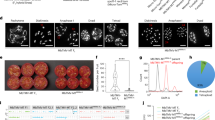Abstract
TRUE-BREEDING diploid mutants have been found to arise from colchicine-treated Sorghum seedlings of the true-breeding lines, Experimental 1 and Experimental 3 1–5. Their true-breeding nature is similar to that obtained after many generations of selfing so that they appear to be immediately homozygous for the new characteristics. Some non-true-breeding mutants also occur. It was proposed that the true-breeding condition might arise by a somatic reductional division of the chromosomes, similar to that observed by Huskins6, with subsequent restoration to the diploid number, and that the mutant condition might arise through concentration of chromatin from one of the original ancestors from which Experimental 3 had been derived. However, from cytogenetic studies of hybrids between true-breeding mutants and their untreated full sibs, the genetic changes appear to be due to gene mutations4,7–9. Tests of the somatic reduction hypothesis using chromosome markers (recessive genes and reciprocal translocations) in the heterozygous condition in sorghum and other materials have not been decisive1,7,10 except for one case in flax (gene markers) which indicated its seeming validity11.
This is a preview of subscription content, access via your institution
Access options
Subscribe to this journal
Receive 51 print issues and online access
$199.00 per year
only $3.90 per issue
Buy this article
- Purchase on Springer Link
- Instant access to full article PDF
Prices may be subject to local taxes which are calculated during checkout
Similar content being viewed by others
References
Atkinson, G. F., M.S. thesis, South Dakota State College (July 1956).
Atkinson, G. F., Franzke, C. J., and Ross, J. G., J. Hered., 48, 259 (1957).
Franzke, C. J., and Ross, J. G., J. Hered., 43, 107 (1952).
Franzke, C. J., and Ross, J. G., J. Hered., 48, 46 (1957).
Ross, J. G., Franzke, C. J., and Schuh, L. A., Agron. J., 46, 10 (1954).
Huskins, C. L., J. Hered., 39, 310 (1948).
Foster, A. E., M.S. and Ph. D. theses, South Dakota State College (March 1956 and August 1958).
Foster, A. E., Ross, J. G., and Franzke, C. J., Agron. J. (in the press).
Harpstead, D. D., Ross, J. G., and Franzke, C. J., J. Hered., 45, 255 (1954).
Hanson, G. P., M.S. thesis, South Dakota State College (June 1958).
Dirks, V. A., Ross, J. G., and Harpstead, D. D., J. Hered., 47, 229 (1956).
Sanders, M. E., Franzke, C. J., and Ross, J. G., Amer. J. Soc., 46, 119 (1959).
Kaufmann, B. P., Hollaender, A., and Gay, H., Genetics, 31, 349 (1946).
Swanson, C. P., and Hollaender A., Proc. U.S. Nat. Acad. Sci., 32, 295 (1946).
Hendricks, S. B., Amer. Scientist, 44, 229 (1956).
Author information
Authors and Affiliations
Rights and permissions
About this article
Cite this article
FRANZKE, C., SANDERS, M. & ROSS, J. Influence of Light from an Infra-red Bulb on the Mutagenic Effect of Colchicine on Sorghum . Nature 188, 242–243 (1960). https://doi.org/10.1038/188242a0
Issue Date:
DOI: https://doi.org/10.1038/188242a0
This article is cited by
-
Colchicine induced interchanges in chillies (Capsicum annuum L.)
Experientia (1983)
-
Colchicine-induced variants in sunflower
Euphytica (1983)
-
Colchicine induced chromosomal interchange in castor beans (Ricinus communis linn.)
Experientia (1968)
-
Colchic ineinduced chromosome mosaic inSorghum vulgare L.
Proceedings / Indian Academy of Sciences (1967)
-
Chromosome mosaics and the recovery of the original strain from octoploidHordeum murinum
Zeitschrift f�r Vererbungslehre (1963)
Comments
By submitting a comment you agree to abide by our Terms and Community Guidelines. If you find something abusive or that does not comply with our terms or guidelines please flag it as inappropriate.



